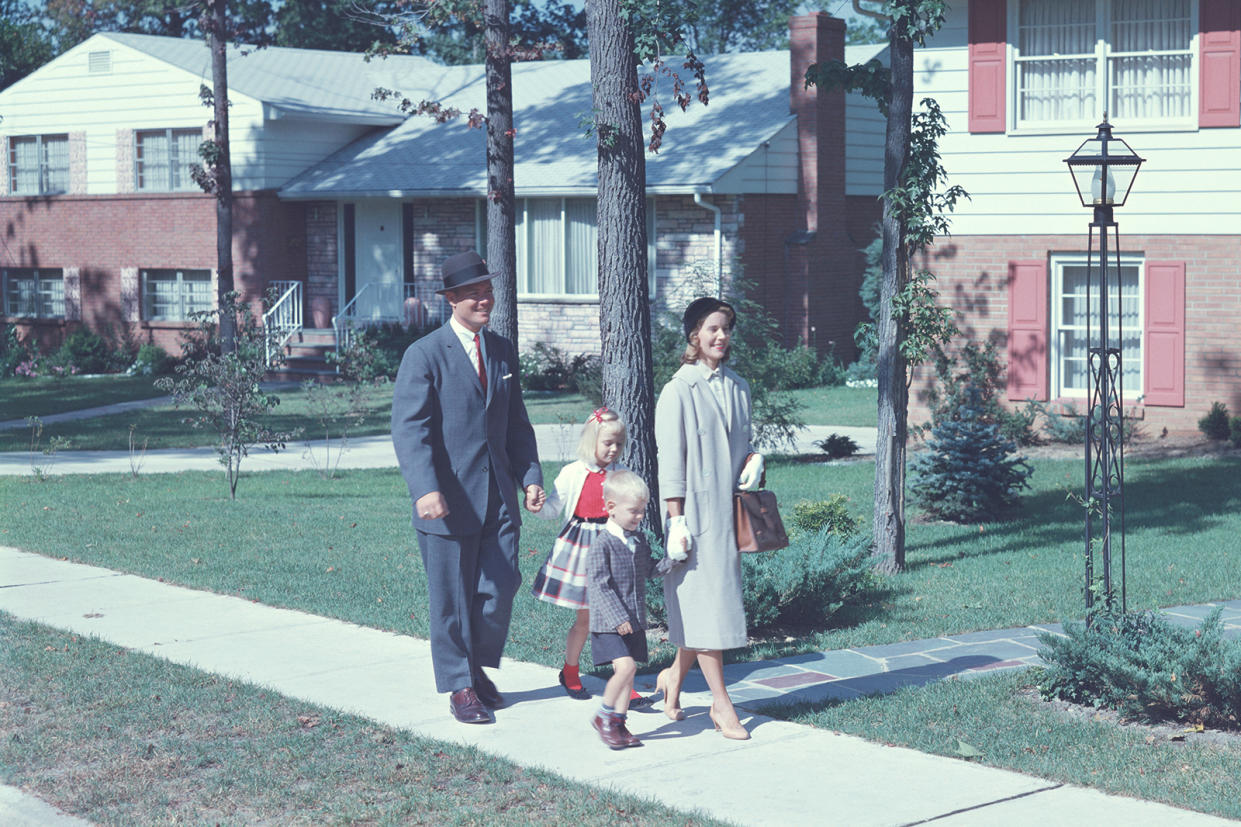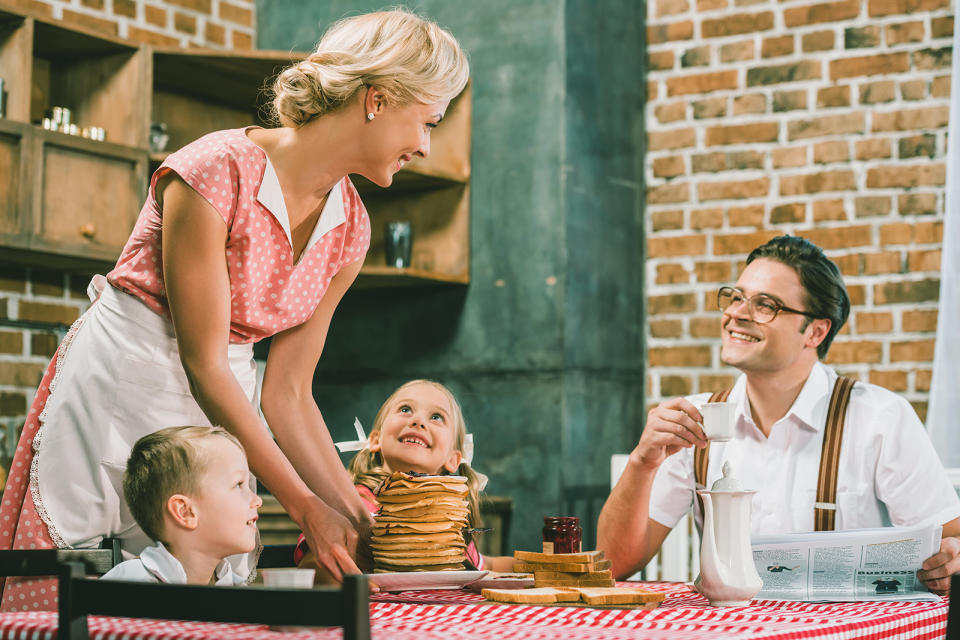What Life in a 1950s Family Was Really Like

When you picture the quintessential 1950s family, Leave It to Beaver and I Love Lucy come to mind. The reality of life in the 1950s was shockingly different. Sure, the porcelain veneer of the traditional American family with a white picket fence, a string of pearls, and a multi-course meal on the table wasn’t entirely untrue.
Yet, the rot running underneath born out of generational tensions and Cold War anxieties proves that the picture-perfect 1950s family never actually existed.
Life in a 1950s Family: Myth Building in Mid-Century America
Nostalgia is a historian’s biggest enemy. Often, cultural memory relies on past media to inform the contexts of the things that you remember. This can sanitize the past, reducing it to the mere shadow of its actual self. This is the case for the 1950s family structure.
The Marriage & Baby Booms Shake Things Up
With over one-tenth of the American population serving in World War II, there wasn’t much time for marrying and having children in the 1940s. With the taste of victory on their lips and a newfound sense of security — that they could have a family who’d live to see the next decade — people married in droves.
Naturally, the marriage boom led to a baby boom as well. More young families started their lives in the late 1940s and early 1950s than in decades prior. It was an opportune time to wipe the slate clean and start anew by building the “traditional” American family.
1950s “Traditional” American Family Mythology
The American propaganda machine didn’t stop churning out messaging after VE Day. In fact, advertising and media programming pumped out a new narrative of the “perfect” nuclear family with its archetypal roles.
The Head of the Family
An ideal 50s family was led by a strong, masculine breadwinner, someone who worked a 9-5 and had few household and child-rearing responsibilities. Everyone deferred to his better judgment, and his rule was law. Though he could be caring and supportive, he wasn’t allowed to show weakness or emotional vulnerability. His life revolved around building a family and a career.
The Submissive Housewife

Queen of the domestic sphere, ideal 50s women were in charge of the household, domestic arts, and child-rearing. They were supposed to be submissive to their husbands, genteel and quiet, but social where it mattered. They were the emotional glue that held their family together and were supposed to accomplish their tasks without complaint.
Revolutionary Road is a highly-acclaimed 2008 film based on the 1961 book of the same name which peeks beneath this porcelain veneer of the idyllic 1950s family structure and is a must-watch for people interested in the subject.
The All-American Son
Every 50s family wasn’t complete until they had their heir-apparent, the All-American son. He was expected to live a clean-cut life, often follow in his father’s career footsteps, and start a family. Following in his father’s vein, he needed to be adept at sports and charm and be able to take charge. No wasn’t a word he heard often, and the weight of his future family’s success rested on his shoulders.
The Dutiful Daughter
The ideal 50s daughter aspired to marriage. She was expected to spend her childhood and teenage years learning the household arts and perfecting her “womanly” duties. Though she wasn’t forced to marry early, she was encouraged to find a “supportive” husband in order to start a family.
Her wants and desires were supposed to take a back seat to her husband’s and children’s. And the only degree she was encouraged to acquire was her M.R.S.
Suburbia Helps Bring This Myth to Life
Before the 1950s, people typically lived in quite rural areas or highly populated metropolitan regions. But a housing development nestled between the two that broke ground in 1947 changed the game. Now a secret third thing — planned living communities — became all the rage. Thanks to Levittown, New York, suburban life was born.
When you think of developments with manicured streets, close-knit neighbors, and homes that shared the same layouts, you can thank the postwar housing boom for starting it all. It was all too easy to market a new family identity when there were brand-new stage dressings to set the scene with.
Yet, growing up in the suburbs could be a great experience for young white kids. From walking to school together and gathering for block parties and barbeques, these places became the safe community centers they all desired.
In 1944, the Servicemen’s Readjustment Act went into effect. Known as the GI Bill, it made attending college and buying homes substantially easier for veterans than it was before the war.
Related: Vintage Dresses: Achieving a 1950s Retro Style
What Families in the 1950s Really Dealt With
Keeping up with the Joneses wasn’t all it was cracked up to be. People in the 1950s might have tried their hardest to live out the perfect conservative American blueprint, but they often fell short. The reality of life in the 1950s is much different than Father Knows Best would like you to believe.
Domestic Containment Targeted Weary Housewives
Women — who had entered the workforce en masse during World War II — were forced to give up their jobs due to familial duty and gender politics. Getting a taste for autonomy and having it stripped away left many women adrift.
American advertisers knew just how to fix the problem — convince women that their real purpose lay in exerting their purchasing power. Having the latest household items, kitchen gadgets, fashion, and finery gave you a leg up on your neighbors. And it helped bolster the war-torn American economy. But, if you’ve ever dealt with the devil that is buyer’s remorse, you know that you can’t solve your emotional problems with material goods.
As if it couldn’t get worse, domestic containment developed in the early days of the Cold War. Basically, it touted the idea that women’s roles were in the home and if they could maintain a beautiful, wholesome, and “all-American” family, they could beat Communism back. In the 1940s, men fought a war in the trenches, and in the 1950s, women went to war at home.
Want to learn more about women’s experiences with marriage and domesticity in the pre-and-post-war period? Check out historian Elaine Tyler May’s book Homeward Bound: American Families in the Cold War Era.
Teenagers Posed Entirely New Problems
In the apropos words of emo band My Chemical Romance, “teenagers scare the living sh*t out of” 1950s American families. Before the Baby Boom, the teenage experience didn’t really exist. Some attribute its rise to Dr. Benjamin Spock’s permissive parenting style, which he explored in his 1946 book Baby and Child Care.
Either way, teens had money to spend, and the freedom to do so. They harnessed their power to influence which films, music, and fashions became popular. Automotive culture gave them the cars they needed to explore their world outside of their parent’s purview. And this independence let them challenge all the expectations that’d been set for them.
This freedom led to a widespread panic about teenage delinquency. On the outside, they feared their kids committing violent crimes and having pre-marital sex, but what they really feared was them breaking free from the careful ‘safe’ mold they’d been raised to fit into.
Related: 10 Ideas for a 50s Theme Party That'll Shake, Rattle, and Roll
White Supremacy Affected all Facets of BIPOC Lives
You can’t look at family life in the 1950s and ignore a massive group of the American population. White supremacy controlled politics and the popular narrative. So the experiences of BIPOC families are so often shunted in favor of highlighting the mythical All-American family.
From redlining to white flight to interracial marriage bans, the 1950s were entirely different for non-white families. They had their own communities’ expectations to contend with, all while trying to fit within the broader American nuclear family framework. Sounds exhausting, doesn’t it?
The first season of Amazon’s series Them artfully and expertly explores the tensions that arise for a southern black family who moves into an entirely white neighborhood in 1953.
The Cold War Heated Things Up
Let it be known that the Cold War was anything but cold. Sure, areas of armed conflict did pop up (aka hot spots) but the major impact it had on everyday Americans was nuclear fear. Throughout the 1950s, there was an omnipresent nuclear threat hanging overhead.
Bomb shelters were built, and kids were forced to practice “duck-and-cover” drills in the case of nuclear fallout. Some schools even issued dog tags so their families could identify their kids’ bodies if the Soviet Union dropped their bombs.
What can we say? It wasn’t called the Atomic Age for nothing.
Life in the 1950s Wasn’t as Perfect as You Think
When you peel back the layers on life in the 1950s, you can see the threads of fear, tensions, malaise, and discontentment peeking through. Simply, life back in the 50s was just a complicated and complex as it is today.

